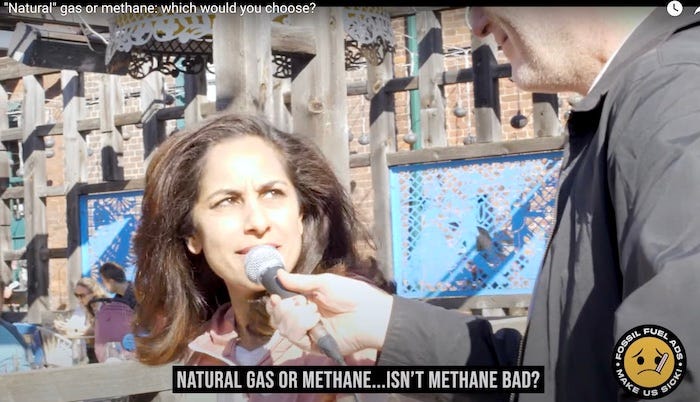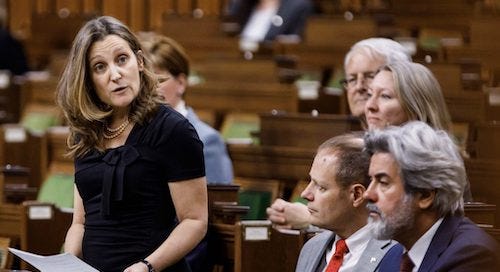Will Freeland’s Clean Industrial Strategy Deliver the Best Bang for the Buck?
The media buzz ahead of the 2023 federal budget points to some smart climate investments, with one exception that IPCC scientists aren’t going to like.
The advance media buzz around Finance Minister Chrystia Freeland’s upcoming budget shows the government taking some big, necessary steps to speed up emission reductions and the shift off fossil fuels—with one serious blind spot.
Anyone who runs a household budget (or tries to) knows that Rule #1 is to get the best bang for the buck. With a limit on what you can spend, you put your money where it’ll do the most good.
That analogy doesn’t usually hold up with something as complicated as a national budget. But with Freeland explicitly warning this year that there won’t be enough dollars to go around, it will be reasonable to ask whether every investment she announces is the best route to the goal she says she wants to achieve.
After the Intergovernmental Panel on Climate Change spotlighted a massive, global gap in clean technology and energy transition investment, the stage is set for Canada’s finance minister and deputy prime minister to deliver on her promise of an “industrial policy for a clean economy”. For many weeks, the advance coverage and trial balloons have suggested she’ll do exactly that. But apparently not in a way that cuts off new taxpayer support for the industry that is doing the most to hold back Canada’s shift off carbon.
Which of These Things is Not Like the Others?
For weeks, Ottawa has been signalling that there’s no uncertainty about whether to throw federal dollars at some of the most promising clean technologies. The only questions are how and how much.
News reports over the last few days have focused on new funding and institutional support for a decarbonized grid, and a 30% investment tax credit for renewable energy and electric vehicle supply chains, including critical minerals. Freeland is also expected to release details of a five-year, $250-million green jobs plan first announced in her fall economic statement.
But for anyone who remembers the Sesame Street children’s TV series, the other side of the story brings us back to the song, “Which of these things is not like the others?” (And now that tune is going to be in my head all weekend, thankyouverymuch!) Because the budget is also widely expected to add to the generous subsidies the government has already put on the table for carbon capture and storage (CCS) in the fossil fuel industry, with added supports for production of “blue” hydrogen derived from fossil gas.
If you’ve been keeping score, you know that CCS—on its own, and as a necessary backstop to blue hydrogen development—is precisely the technology the IPCC identified as delivering the smallest emission reductions at the highest cost through 2030.
But a Finance Canada spokesperson confirmed to The Energy Mix last week that carbon capture will be one of the winners in this year’s budget.
“Carbon capture, utilization, and storage technologies are an important tool for reducing emissions in high-emitting sectors and a key part of the government’s broader plan to work with industry towards the goal of decarbonization,” he said in an email.
The spokesperson didn’t directly answer questions about how or whether the budget could incorporate the IPCC’s dire warnings about the climate emergency. Or its finding that solar, wind, and methane reductions in industry are by far the most promising and affordable ways to deliver faster, deeper carbon cuts by 2030, in a pivotal decade for rapid decarbonization.
How Not to Build a Green Industrial Giant
It’s probably unrealistic to think that a budget scheduled for March 28 would have been influenced, much less fundamentally shifted, by a science report released March 20.
But Freeland and her officials had plenty of warning that further CCS subsidies would be window dressing, rather than a catalyst for real emission reductions.
• The technology is still expensive and unproven, after 50 fitful years of development.
• Carbon capture installations rarely if ever consistently hit their own target and capture 90% of the emissions from the fossil fuel or other industrial plants to which they’re bolted on. Last fall, a review of the world’s 13 “flagship” CCS projects, representing 55% of global capacity, found that seven underperformed, two failed outright, and one was mothballed. The 13 projects combined captured 39 million tonnes of CO2 per year, about one one-thousandth of the 36.3 billion tonnes that emitters poured into the atmosphere in 2021.
• As recently as January, 2021, a report showed that 81% of the carbon dioxide captured through CCS was promptly reinjected underground to squeeze more oil out of depleted wells. (To date, that’s been the ‘U’ in carbon capture, utilization, and storage, or CCUS.) Rather than reducing emissions, the process known as Enhanced Oil Recovery is tailor-made to drive them ever higher.
• Even if it worked as intended, CCS attached to a fossil fuel operation only captures about 20% of the emissions in a barrel of oil. The rest is released when the product reaches its end user and is burned—in other words, when it’s used as directed.
But for the best clue to how Freeland should make the country’s budgeting decisions, look no farther than the way the fossil industry is making its own.
Oilpatch operators like Cenovus Energy have been asking for “clarity” on the fiscal regime for CCS, by which they mean more subsidies. They’d sooner pay out their own massive profits in shareholder dividends and stock buybacks than invest their winnings in the decarbonization technologies they say they want.
In October, the Pathways Alliance, whose six members account for 95% of Canadian oil sands production, teased a $24.1-billion investment in a carbon capture hub and a collection of related projects—but said there would be no final decision unless taxpayers opened their pocketbooks. Yet again.
This from the industry that received more than $20 billion in federal financial support last year.
In the months since the United States put a charge into energy transition investments worldwide with its US$370-billion Inflation Reduction Act, the Canadian fossil sector has complained incessantly that it can’t compete with the new CCS subsidies on offer south of the border. But an analysis released last month by Clean Prosperity and the Transition Accelerator found the investment gap for CCS is relatively small. The real challenge is in areas like battery production, Bloomberg reports, where tax credits available for a project in the U.S. exceed Canada’s by about C$2 billion per year.
Doing Less with Less
In a weird and perverse way, it might be just as well if Freeland’s nod to fiscal restraint means less funding for technologies that have been under development for 50 years, still aren’t ready for prime time, and certainly won’t contribute to the emission reductions we need by the end of this decade. Fossil companies have made it crystal clear they won’t take action on their own, even though carbon capture is the last fig leaf that gives their emissions-intensive operations the slightest hope of climate credibility, after they flatly refused to deliver real carbon cuts by 2030.
But in the midst of a climate emergency, we shouldn’t even be having this conversation.
A budget is meant to be the clearest, most honest statement of a government’s real policy priorities. And on balance, I do believe this federal Cabinet understands the urgency of the climate crisis and wants to put the country on a path to faster emission cuts.
So it’s a shame that Freeland apparently saw the need to dilute the effort, combining some worthy investments with a perpetual fossil subsidy that never seems to quit. If those predictions actually show up in Tuesday’s budget documents, Ottawa will only be able to avoid wasting scarce money and time on the worst available technologies if fossil executives turn down their latest offer.
Mitchell Beer traces his background in renewable energy and energy efficiency back to 1977, in climate change to 1997. Now he scans 1,200 news headlines a week to pull together The Energy Mix and The Energy Mix Weekender.
You can also bookmark our website for the latest news throughout the week.
Video of the Week








